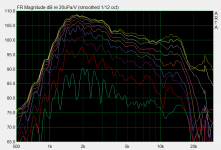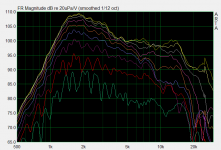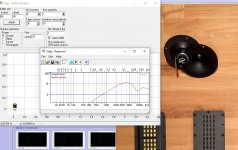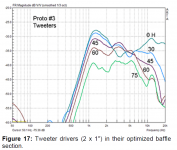I've considered using the AST2560 as a dipole, matching it with the Purifi PTT6.5 (also dipole). I would only do so if it was equally low distortion as the PTT6.5 (or close). Based on your measurements, I'm not sure it reaches that level of performance. Would you agree?
Unfortunately, I've only found dome tweeters that do, specifically the Bliesma tweeters and the SS 9900 and I can't afford using 2 of those back to back for dipole.
I'm afraid, that this one exceeds your price limit as well:
Mundorf AMT25D Bändchen-Hochtöner 6 Ohm AMT25D1.1, 404,34 &
An externally hosted image should be here but it was not working when we last tested it.
However, in my opinion one of the best dipole tweeters, you can buy for money.
Here the distorsion measurement from the manufacturer:
.jpg)
In my opinion a much better solution than using 2 dome tweeters.
I'm using them in my dipole speakers and I am very very happy
It would be nice if anybody had a cogent rationale for what should be broadcast from the back.*
B.
* besides Bose
The same spectrally at all angles for true dipole constant directivity. How much it matters in your average living room is debatable, probably not as much as the dipole police might think
as far as I remember, there is a therory that you do not necessarily need an identical radiation from the backside, but you should try to achieve an identical and homogenous energy response. This sounds plausible for me, if we assume , that radiation from the back reaches the listener after being diffused from reflection of walls and other objects in the listening room.
Having the same constant directivity radiation pattern from the backside would then be a sufficient, though not a necessary, criterion.
Having the same constant directivity radiation pattern from the backside would then be a sufficient, though not a necessary, criterion.
Last edited:
It would be nice if anybody had a cogent rationale for what should be broadcast from the back.*
B.
* besides Bose
Your willful ignorance of what is in front of you is not flattering.
-OR-
You can lead an old horse to water but you can't make it drink.
(your choice)
Perhaps you have not read my reply here:
In Pursuit of a 20-20k Dipole Loudspeaker
Last edited:
I'm afraid, that this one exceeds your price limit as well:
Mundorf AMT25D Bändchen-Hochtöner 6 Ohm AMT25D1.1, 404,34 &
However, in my opinion one of the best dipole tweeters, you can buy for money.
Here the distorsion measurement from the manufacturer:
In my opinion a much better solution than using 2 dome tweeters.
I'm using them in my dipole speakers and I am very very happy
I'm very jealous! Yes, the AMT25D1.1 is very good and distortion about 5-10 times lower than other planar drivers. But my two domes back to back has distortion that is almost that low and only costs less than $40 instead of $675 in the US! The Mundorf stuff is way too expensive for just about everyone. But I would be very happy if I was lucky enough to own it!
Charlie, I just looked at your measurements of double domes - looks like they have same polarity. Did you measure them both ways, bipole and dipole?
Do you remember this thread with measurements, started by Rudolf Finke? On the directivity of dipole tweeters
and on 2pi homepage Investigations
Do you remember this thread with measurements, started by Rudolf Finke? On the directivity of dipole tweeters
and on 2pi homepage Investigations
Last edited:
Charlie, I just looked at your measurements of double domes - looks like they have same polarity. Did you measure them both ways, bipole and dipole?
Do you remember this thread with measurements, started by Rudolf Finke? On the directivity of dipole tweeters
and on 2pi homepage Investigations
The dome tweeters are definitely wired in reversed phase to operate like a dipole. The tweeter has one large and one small solder tab to indicate polarity. I wired them like this:
(+) input from amp connects to the large tab on the front tweeter
a jumper wire connects the front tweeter's small tab to the rear tweeter's small tab
(-) input from amp connects to the large tab on rear tweeter
I have attached the response family (front and rear) of a slightly earlier version of this two-tweeter dipole that I have used in a loudspeaker system, crossed over at 1.6kHz. If you hover over the image you get info in the filename at the bottom of the browser window about angles used and which is the front or rear.a jumper wire connects the front tweeter's small tab to the rear tweeter's small tab
(-) input from amp connects to the large tab on rear tweeter
Attachments
Last edited:
I've considered using the AST2560 as a dipole, matching it with the Purifi PTT6.5 (also dipole). I would only do so if it was equally low distortion as the PTT6.5 (or close). Based on your measurements, I'm not sure it reaches that level of performance. Would you agree?
Unfortunately, I've only found dome tweeters that do, specifically the Bliesma tweeters and the SS 9900 and I can't afford using 2 of those back to back for dipole.
Believe me, and many other who have tried: you cannot just take a pair of any old tweeter and put them back to back to form a dipole. The pattern will likely look terrible. Many have tried.
I have not found many, if any, dipoles formed by two dome tweeters places back to back that have a better pattern than what I show above. The tweeters are inexpensive, and distortion is relatively low above 2kHz. You can even use a lower crossover point, because to equalize the driver flat you will be reducing the SPL in the vicinity of 2kHz by over 10dB, and this keeps distortion down around the crossover point. With a crossover point at 2kHz or higher, these are pretty good. They are not going to best e.g. the Mundorf AMT25D1.1 but two of them do cost about 35 times less!
Charlie's el cheapo tweeters seem to have conical waveguide, which explains high spl around 2kHz even in dipole configuration.
Here is a quick Edge sim 60x90 elliptical "baffle" and a planar radiator. Dipole first null is so high that it isn't an audible problem to elderly people!
Here is a quick Edge sim 60x90 elliptical "baffle" and a planar radiator. Dipole first null is so high that it isn't an audible problem to elderly people!
Attachments
Charlie's el cheapo tweeters seem to have conical waveguide, which explains high spl around 2kHz even in dipole configuration.
Here is a quick Edge sim 60x90 elliptical "baffle" and a planar radiator. Dipole first null is so high that it isn't an audible problem to elderly people!
The tweeter unit is the Dayton ND25FW-4. They are sold for under US$20 each. You can find more info here:
Dayton Audio - ND25FW-4 1" Soft Dome Neodymium Tweeter with Waveguide 4 Ohm
The datasheet includes on and off axis frequency responses for a single tweeter. You can see that the waveguide is not really effective until at least 2.5kHz or 3kHz. If you model a 125mm flat, round baffle with a centrally located 25mm source the dipole peak is located at about 2.8kHz.
For the back to back pair as a dipole, at 1.5kHz each tweeter is operating like a monopole. I think may have just been lucky in that the separation distance works out right for them to constructively interfere as a dipole, e.g. the dipole peak is still above this frequency. The edges of the two units are about 1 inch apart and the waveguide is 4" in diameter, so this works out to about 5" (125mm) separation or so. I know when I was first testing out this configuration I took some measurements with a larger separation and the pattern did start to break down at "middle" frequencies like 3k-5kHz. Once the separation was reduced by nesting the two units, I got the pattern shown in the plots. I think this is why most tweeters will not work this way even if they have a waveguide, because most of them will have too large of a magnet structure to allow the domes to be brought close enough together to avoid pattern breakdown. The only way I see it working is if the waveguides are significantly larger and provide directivity to a lower frequency. This is driving my interest in the torus baffle project, especially if the torus shape is changed to look like two waveguides, back to back, which I proposed in post #101 of that thread.
Last edited:
Believe me, and many other who have tried: you cannot just take a pair of any old tweeter and put them back to back to form a dipole. The pattern will likely look terrible. Many have tried.
I have not found many, if any, dipoles formed by two dome tweeters places back to back that have a better pattern than what I show above. The tweeters are inexpensive, and distortion is relatively low above 2kHz. You can even use a lower crossover point, because to equalize the driver flat you will be reducing the SPL in the vicinity of 2kHz by over 10dB, and this keeps distortion down around the crossover point. With a crossover point at 2kHz or higher, these are pretty good. They are not going to best e.g. the Mundorf AMT25D1.1 but two of them do cost about 35 times less!
How about single tweeters that can be used dipole (like the Aurum Cantus AMTs or the dipole Mundorfs)? Can I expect that doing that is more likely to lead to success? Also, is there any consensus on why it's so difficult to get good results from back to back tweeters?
Lastly, if I were to put an AST2560, set up for dipole, in a symmetrical (forward and backward) waveguide, could I expect that to work or also be problematic (assuming the waveguide was well designed)?
Last edited:
How about single tweeters that can be used dipole (like the Aurum Cantus AMTs or the dipole Mundorfs)? Can I expect that doing that is more likely to lead to success? Also, is there any consensus on why it's so difficult to get good results from back to back tweeters?
Lastly, if I were to put an AST2560, set up for dipole, in a symmetrical (forward and backward) waveguide, could I expect that to work or also be problematic (assuming the waveguide was well designed)?
There are several "ribbon" (or AMT, I lump these together) tweeter models that can be used as a dipole. I provided a measurement of the AST2560 earlier in this thread (not sure if you saw it or not). The only downside is that these drivers tend to have higher levels of distortion that other types of tweeters unless pay quite a bit extra (e.g. Mundorf).
When you try to use two domes back to back the result often is a much less than "dipole" like response pattern. At around 1kHz a 1" dome tweeter is radiating much like a monopole and its not until higher frequencies that it will start to be directional enough to not interact with the "other" tweeter. A waveguide seems to be helpful in lowering this threshold, based on anecdotal information at least.
I would be very interested in any experiments with, and measurements on, back-to-back waveguides with either two dome tweeters or a single dipolar ribbon. There is another thread running now (title: Did Siegfried Linkwitz miss a trick?) in the full-range forum where some modeling has been done in this direction, but primarily for a "mid-woofer" in a "toroidal" shaped guide structure.
Based on my experience, I think a dipolar tweeter in back-to-back waveguides can work, but it might depend on the size of the waveguide, etc. Hopefully we will learn more in the near future.
NEW FLASH: AST2560 IS ON SALE NOW!
I just discovered that the Aurum Cantus AST2560 tweeter (see measurements at beginning of thread) is on sale at Parts Express until the end of the year (according to the chat session I had with a sales rep). They are currently out of stock but should have more in about 2 weeks time.
According to my measurements this seems like a great option for a nude dipole tweeter.
I just discovered that the Aurum Cantus AST2560 tweeter (see measurements at beginning of thread) is on sale at Parts Express until the end of the year (according to the chat session I had with a sales rep). They are currently out of stock but should have more in about 2 weeks time.
According to my measurements this seems like a great option for a nude dipole tweeter.
Thanks to forum member fluid, I happened to read the following a paper by Linkwitz in which he talks about his LX521 speaker:
https://www.linkwitzlab.com/IJAETv2n2a2-Linkwitz-1.pdf
If you look at page 123, section 4.1.4 Dipolar Tweeters, he has this to say:
As you can see in Figure 17 (attached), there are some significant problems in the 2.5k to 6.5kHz frequency range. Above this the tweeters are getting directional and their output does not see the baffle, and from what he (SL) told me this is why he chose the 7.5kHz crossover point. I think he would have liked to use a lower one, but could not because of the response issue.
So, with my back-to-back "el cheapo" (to quote Juhazi) dome+waveguide tweeters I have been able to avoid this sort of problem completely. I think it is pretty novel in this regard.
https://www.linkwitzlab.com/IJAETv2n2a2-Linkwitz-1.pdf
If you look at page 123, section 4.1.4 Dipolar Tweeters, he has this to say:
Figure 17 shows the on and off axis response of the pair of tweeters he chose to use in the LX521. These are small flange 1" dome tweeters, and he installed them on opposite sides of a narrow baffle, one elevated above the other.Radiation from front and rear tweeters interacts in
space forming a radiation pattern with sound
cancellation in the plane of the baffle and a dipole-like
angular dependency, Figure 17. Below 2kHz the baffle
is acoustically small and a true dipole response results.
Above 5kHz the inherent directivity of the dome drivers
takes over. Front and rear radiation only interact at
large off-axis angles. An LR4 crossover at 7.5kHz was
chosen to combine the tweeters with lower and upper
midranges.
As you can see in Figure 17 (attached), there are some significant problems in the 2.5k to 6.5kHz frequency range. Above this the tweeters are getting directional and their output does not see the baffle, and from what he (SL) told me this is why he chose the 7.5kHz crossover point. I think he would have liked to use a lower one, but could not because of the response issue.
So, with my back-to-back "el cheapo" (to quote Juhazi) dome+waveguide tweeters I have been able to avoid this sort of problem completely. I think it is pretty novel in this regard.
Attachments
Your willful ignorance of what is in front of you is not flattering.
-OR-
You can lead an old horse to water but you can't make it drink.
(your choice)...
Hello, Charlie, having a bit of trouble with your anger management today? "OLD horse"... isn't the actual saying, just an insult you wanted to add.
Time for an apology.
As far as I know, there's no reason to expect front and back sound to be alike from dipoles or many dipole drivers, the acoustic environment behind a dipole is obviously different from the acoustic environment in front, and obvious inconsistencies in the box construction.
I'd say, kind of a historical accident arising from ESLs (the first serious dipoles) that anybody ever thought it made sense to have identical front and back sound. Why?
Which leads to the obvious conclusion that a designer should think about what they really want (1) coming out the back and (2) around.*
Without saying anything too nice about the original Bose, they did seem to be a revelation to many listeners. They were the first exposure to ambience as an audiophile goal for many listeners - some of whom may have gone on to dipole enthusiasm. Seven-back and one-front drivers? Lotsa EQ?
B.
*Supporting simpler models, as per your earlier "reply", is not important to DIY builders and seems just plain pedantic
Last edited:
I'd be interested to learn to what degree constant directivity matters in a "normal" living room. Also, of the many attributes of dipole/OB speakers how important they are to people's perception. For example, early reflections seem not to be a problem for Charlie.
Here is part of the abstract from Linkwitz's paper "The Magic in 2-Channel Sound Reproduction - Why is it so Rarely Heard?" with my emphasis in COLOR:
In a reverberant room, where the listener not only hears the direct sound but also the reflected sound, i.e. the off-axis radiated sound, the ear-brain perceptual apparatus must be allowed to withdraw attention from room and speakers and focus attention upon the direct sound to create a convincing illusion of the reproduced acoustic event. For this to happen misleading perceptual cues must be eliminated. The speakers must be placed so that reflections are delayed relative to the direct sound. The speakers must be free from spurious resonant radiation and their off-axis radiation must follow their on-axis frequency response for the reverberant sound to be neutral. The polar radiation pattern must be essentially either omni-directional, cardioid or dipolar, aiming for constant directivity.
Constant directivity insures that the response "shape" (or relative level of one frequency to another) at any one angle is the same as for all other angles off axis, just with a level difference. It's simply what the phrase "the off-axis radiation must follow their on-axis frequency response" means.
The idea, as I understand it, is that the off axis radiation will reflect one or more times and finally reach the listener as a an "echo" of the direct sound. The brain will fuse that with the direct sound, and that will "enhance" the stereo effect. As the off axis radiation becomes less and less like the on axis sound, the reflected echoes will "distract" the brain and detract from the stereo effect.
Apart from the off axis radiation itself, the room surfaces (wall material and window decoration, carpeting vs hardfloor, hard chairs vs stuffed seating, etc.) will also impart a "filtering" effect on the reflections. I think this is why OD and dipole systems do not sound all that great in rooms that are relatively dead due to lots of adsorption - it's nearly impossible to make the amount of adsorption even across the audio spectrum. The best soundstage I have experienced with a dipole system was in a relatively large bare room, with mostly hardwood flooring plus some tile, sheet rock walls, and only one lone couch in the middle. It was almost too live but the effect from the dipole was stunning.
- Home
- Loudspeakers
- Planars & Exotics
- measurements of nude ribbons and a dome-dipole



